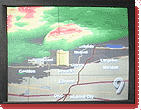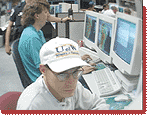|
 Dennis
and another staffer by now were working 2 or 3 ham radio mikes at once,
asking spotters for the latest, checking maps showing where they were
calling in from, telling that them conditions were now so severe that
only winds above 60 miles per hour, large hail, rotating wall clouds,
and twisters were worth taking up valuable air time. The TV was now
on one of the trusted local stations, whose forecaster and chase teams
had proved invaluable last May 3rd: TV graphics began to show maps and
then, there it was, twister on the ground. Dennis
and another staffer by now were working 2 or 3 ham radio mikes at once,
asking spotters for the latest, checking maps showing where they were
calling in from, telling that them conditions were now so severe that
only winds above 60 miles per hour, large hail, rotating wall clouds,
and twisters were worth taking up valuable air time. The TV was now
on one of the trusted local stations, whose forecaster and chase teams
had proved invaluable last May 3rd: TV graphics began to show maps and
then, there it was, twister on the ground.
 Joey
and another intern, and the met. tech. who launched the balloon, staying
after his shift was over, were now frantically calling emergency managers
to alert them, and members of the general public along the projected
route of the storm, inviting them to provide input about what size hail
they were seeing and what kind of winds they were hearing. I'd thought,
researching how the Weather Service worked, that everything was now
pretty much automated, that machines provided all the data. This night
showed just how wrong that was: "when the vortex hits the voters", as
someone memorably said at the National Hurricane Center, it's humans
who have to interpret and make the call. What was also very apparent
was that the NWS was just one player--albeit the key and lead actor--in
a vast network of weather-related organizations, including the media,
local emergency services, and more. Joey
and another intern, and the met. tech. who launched the balloon, staying
after his shift was over, were now frantically calling emergency managers
to alert them, and members of the general public along the projected
route of the storm, inviting them to provide input about what size hail
they were seeing and what kind of winds they were hearing. I'd thought,
researching how the Weather Service worked, that everything was now
pretty much automated, that machines provided all the data. This night
showed just how wrong that was: "when the vortex hits the voters", as
someone memorably said at the National Hurricane Center, it's humans
who have to interpret and make the call. What was also very apparent
was that the NWS was just one player--albeit the key and lead actor--in
a vast network of weather-related organizations, including the media,
local emergency services, and more.
 As
those 2 rare December tornadoes touched down it felt more like being
inside "E.R." in the middle of a particularly frenetic episode than
anything else. And the men and women of the National Weather Service
whom I saw at work that night were as heroic as the leads in any primetime
drama, all those fictional hours hours of "make-believe" excitement
that had been pre-empted that stormy night in Norman. Here they were,
applying all the science of tornado genesis, the workings of up and
down drafts--all the principles we hope students will be exposed to
in LIVE FROM THE STORM. They were deciphering data with new algorithms
and colorful displays, putting computers and the tools of the Information
Age to work, just as we hope students will do with our online resources.
But this was for real. And this was impressive. And I felt very lucky
to see such dedication and skill in action. Dennis in his understated
way, commented that these storms had turned out to be very "productive",
and this scouting trip too had been productive. I'd seen in real life
with real people and real challenges how NOAA puts its mission statement
to work--applying weather and climate science to serve and protect the
public. As
those 2 rare December tornadoes touched down it felt more like being
inside "E.R." in the middle of a particularly frenetic episode than
anything else. And the men and women of the National Weather Service
whom I saw at work that night were as heroic as the leads in any primetime
drama, all those fictional hours hours of "make-believe" excitement
that had been pre-empted that stormy night in Norman. Here they were,
applying all the science of tornado genesis, the workings of up and
down drafts--all the principles we hope students will be exposed to
in LIVE FROM THE STORM. They were deciphering data with new algorithms
and colorful displays, putting computers and the tools of the Information
Age to work, just as we hope students will do with our online resources.
But this was for real. And this was impressive. And I felt very lucky
to see such dedication and skill in action. Dennis in his understated
way, commented that these storms had turned out to be very "productive",
and this scouting trip too had been productive. I'd seen in real life
with real people and real challenges how NOAA puts its mission statement
to work--applying weather and climate science to serve and protect the
public.
Ed note:
To see more of what this evening was like in text and images, check
out the FIELD CAMPAIGN section of the LIVE FROM THE STORM web site later
in February. And read more comments from Doug
Speheger and Dennis online under FIELD JOURNALS.)
|


![]()